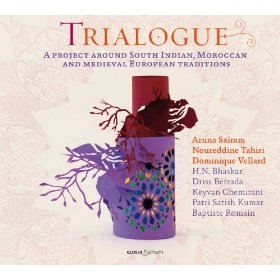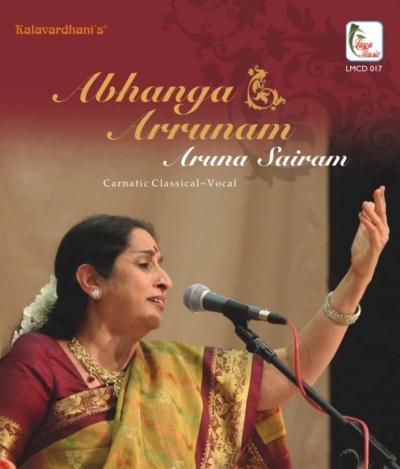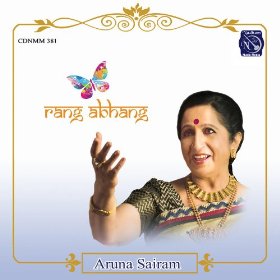Her Song and Story
-
By:
HEMA VIJAY
It's a grossly under-recognised facet of her musical persona. Over the years, Carnatic maestro and Padma Shri awardee Aruna Sairam, vice chairperson, Sangeet Natak Akademi, has been composing pallavis with thematic storytelling, even while retaining the intricacy of the pallavi, with all its associated academic excellence, mathematical complexity and rich patterning. This singer recognises the huge scope of stories. Stories allow for complex thoughts to get transmitted even across generations. The Puranas, for instance, present the truths of the Upanishads through stories. "The academically knowledgeable listeners will remember the hardcore elements of the katcheri; but the rasikas, they will keep remembering the story," she muses.
For instance, one of her pallavis narrates the story of the eight Lakshmis; others were about M S Subbulakshmi, the 'Sangeetha Mummurthigal' of Carnatic music, the arupadai veedu of Lord Muruga, the namashivaya panchaaksharam that had pentatonic ragas in the complex kanda nadai, and so on. "The last 20 minutes of the concert is what I devote to abhangs, Tamil compositions and the like, but their impact stays with the audience," she acknowledges.
A beautiful childhood
The 650-square-foot house in Mumbai's Parsi Colony, where Aruna lived as a child, often hosted maestros like M S Subbulakshmi, Ariyakudi, T R Mahalingam and many others. That was also how she met her guru (Sangeeta Kalanithi) T Brinda. "I guess these maestros preferred the simple home food, stimulating conversations and homely care my parents offered in preference to fancy hotels. I remember my house was always crowded; musicians would put down their boxes wherever they found space... and there would be hours of conversations over pongal and gotsu."
"My parents gave us a lovely, pressure-free childhood. My mother would impulsively do things. On a whim, she once took me and my brother on a bus trip crisscrossing the temples of Tamil Nadu. She would teach me a new song en route to every temple, and I would sing it at the temple. She also instilled values in us by living them, rather than preaching them to us. My dad was a thoughtful parent too. He would come home with tickets for a movie or a concert on the eve of examinations. He would tell us that what we had studied over the days was what mattered, and that we would in fact write better in exams without all the pressure and cramming," she looks back.
At the same time, there was disciplining. Whenever she came back home from school, whatever class her mother was teaching then, Aruna had to join in. This meant that Aruna was singing everything from sarali varisai to dikshitha kritis. Aruna adds, "My mother also put a fun element into learning. She never made me think that I was working hard."
Her musical canvas
The musical journey that began thus has continued with a flourish. Aruna's gurus later included S Ramachandran, A S Mani, Balamurali Krishna, T R Subramanyam, veena maestro K S Narayanaswamy, and even German maestro Eugene Rabine, and New York-based 'voice teacher' David Jones who helped her improve and polish her vocal delivery, "Finesse can always be improved. Breath is the source of sound; nadam originates from the naabhi. Thyagaraja phrases this beautifully: 'Shobillu saptaswara, naabhi hruth khanda rasana naasaa dhoolayentho'," she voices.
Along the way, Aruna has collaborated with noted international musicians. 'Aruna - Thousand Names of the Divine Mother' was recorded in the crypt of a Benedictine monastery in Germany with co-artistes Christian Bollmann and Michael Reimann. " We were travelling by car and I was chanting lalitha sahasranamam, something I do every morning. Christian Bollmann, a multi-instrumentalist, loved the chant and took me directly to the Benedictine crypt and we recorded this."
Then, there is 'Sources: Devotional Chants of Southern India and Medieval Europe', her collaboration with Dominique Vellard, a master of Gregorian and medieval songs; 'Between Heaven and Earth', her collaboration with Dominique and Moroccan Sufi vocalist Noureddine Tahiri; 'Matrubhumi' with Shankar Mahadevan; 'Strains of Heaven', a duet concert with Mandolin U Srinivas; 'Aikya' in 14 Indian languages; 'Yantra' and 'Bhinna-Pravaha' with dance choreographer Chandralekha; 'Sammohanam' with Malavika Sarukkai, and more.
On global shores
Aruna recently gave a concert at California's Ojai Music Festival, becoming the first Carnatic musician to sing at the 70-year-old festival. It was a hardcore katcheri, the kind you would hear at a Chennai Sabha in December...and the audience loved it, and Aruna has been invited for the festival's forthcoming edition.
The unwritten rule of the festival that has performances, conclaves and lec-dems happening in different venues over several days is that every artiste attends others' programme when not performing personally. "That's thrilling for any performer," says Aruna.
As vice-chairman of Sangeet Natak Akademi, Aruna has been acquainting herself with art and artistes from across the country, learning about their conditions, aspirations, frustrations. "It has been an eye-opener. There is so much that can be done. Except for a few grants and scholarships, artistes are pretty much on their own; we have to come together and help each other. It is a vast canvas...the task is huge, with each state of our vast country having a zillion variations of classical, folk and tribal art forms."
One of the Akademi's targets is to revive the country's lost music traditions. For instance, farmers across the country had this tradition of coming together every evening to sing, dance and share experiences, which buoyed up their psyche. "That tradition is largely gone now. Correlate this loss with the rise in farmers' suicides and connect the dots," she suggests. The Sangeet Natak Akademi's proposed Kisan Sangeet All-India Forum will hopefully address this.
Likewise, the Akademi has proposed to the central government to make it compulsory in government-run schools across the country, right down to the most far-flung villages that every child in primary school should learn five songs a year, with one song in their native language; that they should learn four dances, be part of three skits. "That way, we will create generations of citizens who have been sensitised to art and culture. This is good for both their psyche and for national integration," explains Aruna.
Finally, is Aruna a devotee at heart, or an artiste? "Is one exclusive of the other? I have been taught and given the legacy of a high quality of music. I like to express it. If I am singing for god, and if the music evokes divinity in the listeners, I see god in the listeners," she avers.
Related Albums

Trialogue
Published : 2012
By : Glossa Music
Abhanga Arunam
Published : 1994
By : Kalavardhini's
Rang Abhang
Published : 2011
By : Nadham Music Media
Related Concerts
- Bolava Vitthal - Celebrating Ashadhi Ekadashi An Evening of Abhangs
On : Friday, July 27, 2018
